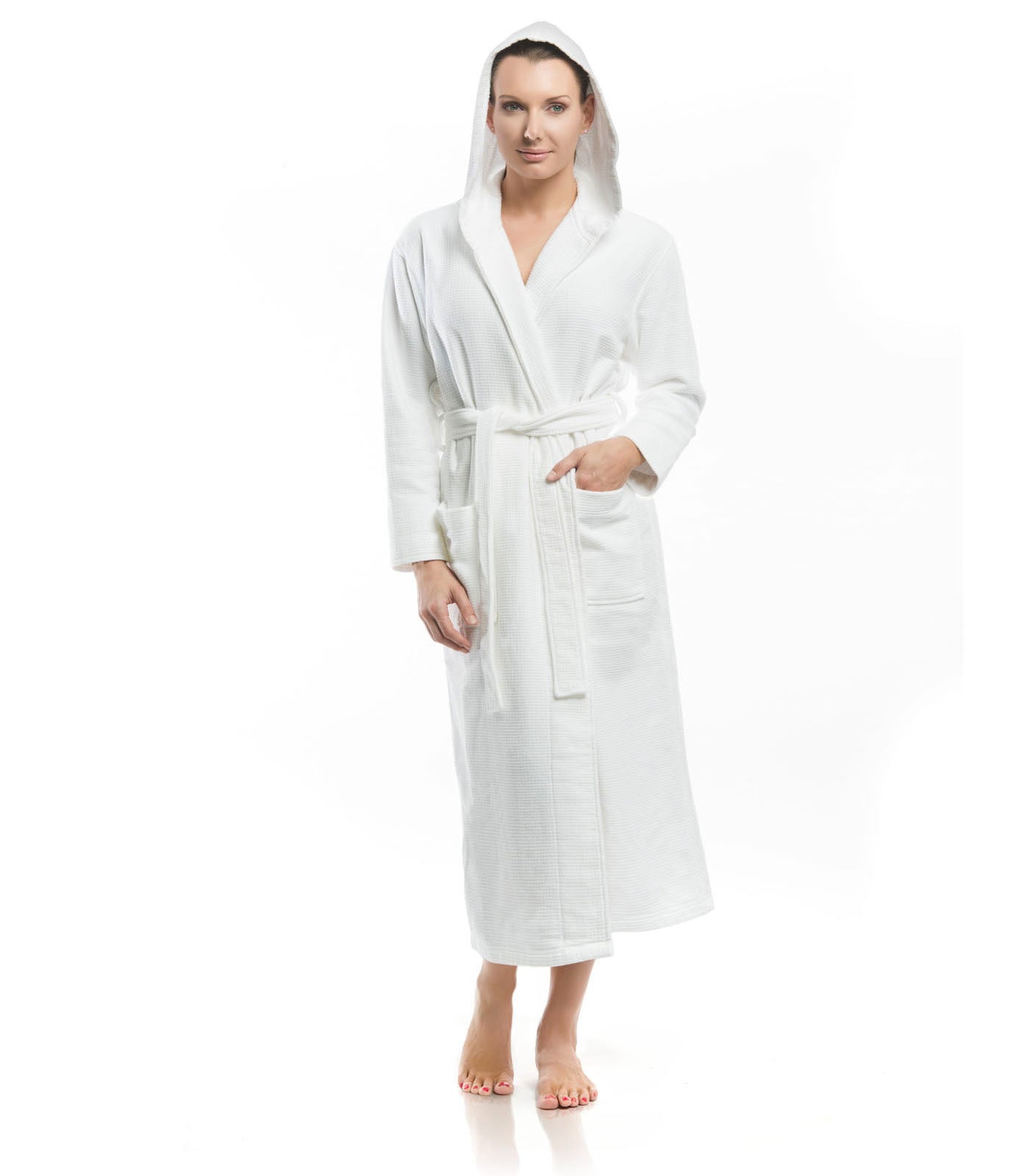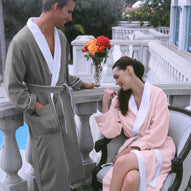Robes Around the World: Cultural Significance and Styles
A symphony of comfort and sartorial elegance captured in a single garment, robes hold an extensive cultural significance that traverses continents and centuries. From the opulent silk kimono robes of Japan to the unassuming towel-wrapped bathrobes of Western households, these flowy attires are more than mere clothing—they are symbols of tradition, rites, and social status.
At Plush Necessities we know all about the importance of robes throughout history. In this guide, we’ll come to a deeper understanding of the cultural significance of the garment, as well as how different regions around the world wear it.
Cultural Significance of Robes

Historical Background
Robes have been found in various forms throughout history, attesting to their universal and timeless appeal. They have cloaked the warriors of mighty empires, swathed the figures of religious leaders in temples, and danced along with diplomats who roamed the Silk Road. Each epoch and civilization crafted robes that encapsulated their unique aesthetic and ethos, reflecting the spirit of their times.
Symbolism and Meaning
The robe, with its present ubiquity, has often been relegated to the mundane. However, in many cultures, the robe-wearing is a meaningful act. It can:
- Denote passage into adulthood
- Signify profound spiritual experiences
- Represent formal events
And other important events. The intricate motifs and fabrics used can also signify familial lineage, regional affiliations, and devotion to deities or philosophies. Robes are the adages that cultures wear on their sleeves, passing down stories from generation to generation.
Rituals and Ceremonies
Think of significant formal occasions, and you’re likely to picture robes in some capacity. Graduations, religious ceremonies, and cultural festivals often involve the wearing of special robes. When specific robes are used in formal events, they often serve as unifiers, as every individual aligns their personal narrative with the collective image that the robe represents.
Robe Styles Across Different Cultures
The rich tapestry of global robe styles forms a vital part of our collective rich cultural heritage.

East Asian Robes
Asia’s diverse tapestries bring forth an array of robe styles, each emblematic of the region's rich history and customs. The ceremonious folds of the traditional kimono robes, characterized by its T-shaped silhouette, embody understated elegance in Japan. Meanwhile, the vibrantly-hued hanbok of Korea and the form-fitting cheongsam of China speak volumes of youthful charm and dignified femininity. These robes are not just fashion statements; they encapsulate the philosophy of living in harmony with nature, self, and others.
Middle Eastern Robes
Enveloped within the sands of time and as old as ancient Egypt, Middle Eastern traditional garb styles epitomize modesty, tradition, and faith. The black abaya, a symbol of modest apparel for women in the Gulf States, holds stories of resilience and wisdom within its folds. The djellaba and thobe for men, with their loose cuts and simple lines, offer comfort and tell of timeless nomadic lifestyles and graceful adaptation to harsh desert environments. These robes resonate deeply with a cultural woven fabric with respect for heritage and devotion to divinity.
African Robes
African robes are as varied as the continent's landscape, speaking dialects of color and character. The dashiki of Western Africa, traditionally worn by men, is a proclamation of identity and cultural unity. The boubou—a flowing robe of varying lengths, commonly worn from Nigeria to Senegal—proclaims the stature and elegance of its wearer. The illustrious kente cloth from Ghana is not just an assemblage of threads but a cohesive storybook of Ashanti heritage. African robes stand as beacons of diversity and distinction, testifying to the continent's vibrancy and significant societal roles.
Western Robes
In the annals of Western history, academic and clerical robes stand out. The solemn regalia of the scholarly class and academic robes are not mere vestments but symbolic of scholarly attainment and continuity of knowledge. The stately robes of clergy, with their ecclesiastical hues and theological and intricate embroidery, serve as outward signs of consecrated service and spiritual authority. From the hallowed halls of academia to the echoing aisles of cathedrals, Western robes uphold traditions and mark the passage of wisdom and spiritual devotion.
Indigenous Robes
Around the globe, indigenous peoples have had culturally significant robes for centuries. Native American tribes adorned ceremonial robes with symbolic patterns and colors, allowing them to as storytelling devices. The Inuit parka, crafted from durable reindeer skin and other animal hides, embodies centuries of ingenuity in adapting to Arctic climates. In Australia, the Aboriginal possum-skin cloak, intricately decorated with traditional motifs, symbolizes cultural identity and spiritual connection to the land.
These indigenous robes are not just attire; they are embodiments of resilience, tradition, and a profound reverence for the natural world, carrying forward the wisdom of generations past into the present day.
Global Influence and Adaptation
While traditional robe styles continue to hold sway, cultural intermingling has sparked new interpretations and adaptations. Modern fashion enthusiasts constantly draw inspiration from the fusion of global robe styles, creating multifaceted expressions that resonate with contemporary sensibilities and accommodating robes that are suitable for everyday wear.
Cross-Cultural Exchange and Adoption
Robes from various corners of the earth have transcended geographical boundaries, forging a common thread among disparate cultures. The regal textile of a Turkish caftan might find its way onto a runway in Paris, infusing a touch of the exotic into Western couture. Conversely, the sleek lines of a European dressing gown might provide the blueprint for a modern take on the Japanese yukata. In these exchanges, we witness a celebration of diversity and the evolution of global fashion.
Modern Interpretations and Fusion
Modernity has not just witnessed a global exchange of robe styles but also a creative re-imagination of traditional clothing. Innovative cuts, fabrics, and design elements are being incorporated into robe styles, giving birth to pieces that honor heritage while breathing a new, cosmopolitan life. High-fashion runways often see a blending of robe aesthetics, producing looks that are at once timeless and trendy, paying homage to their cultural roots while appealing to a contemporary audience.
Impact of Globalization
The surge of globalization and the digital age have given robes visibility like never before. Social media and online marketplaces have become modern-day caravanserais, where robe enthusiasts from around the world connect and share their love for these timeless garments. Embroiderers, weavers, and designers now have an unprecedented platform to showcase their craft, sparking a renewed interest in traditional robe styles and providing a global audience access to the diverse world of robe fashion.
Robes Reborn: Modern Interpretations and Trends
In contemporary society, robes no longer only belong to the ancient or the elite. They have made a comeback, not just to keep the wearer warm but to keep up with rapidly changing fashion sensibilities.

Robes on the Catwalk
Designers all over the world have been breathing new life into the robe concept, incorporating it into their collections and runway shows. From luxurious satin dressing gowns to the casual elegance of the bathrobe coat, the modern robe takes on various forms, all the while nodding to tradition in both subtle and overt ways.
The Influence of Robes on Celebrity and Popular Culture
Robes have also slipped into the spotlight of popular culture, making celebrated appearances in film and television. The iconic Hugh Hefner robe has become a symbol of luxury and leisure, while characters like Dumbledore from Harry Potter have further elevated the robe’s mystical appeal to broader audiences.
Sustainable Swathing
The cloak of sustainability has been drawn over the shoulders of the modern robe trend, with more consumers and designers seeking to create and purchase clothing that has less environmental impact. This has led to the rise of ethical robe fashion, incorporating organic fabrics and responsible production methods that honor both the tradition of the garment and the earth.
Preserving the Legacy
With increased globalization and cultural exchange, there’s a growing conversation around preserving the unique traditions that robes represent. How can we honor the original meaning of these garments while incorporating them into a modern, connected world?
Ethical Production and Respect for Traditions
The shift towards ethical practices in fashion is not only about choosing the right materials but also about craftsmanship and authenticity. Brands are beginning to collaborate with traditional artisans to ensure that robes, when made, do not just bear a superficial likeness to the original, but are imbued with the same care and meaning.
Cultural Exchange in Fashion
Robes from different cultures have the potential to emerge as a symbol of unity and shared human experience. Fashion shows that spotlight the beauty of traditional robes as fashionable garments offer a platform for different cultures to connect and appreciate each other. This cross-pollination of ideas, diverse cultures, and styles gives robes a new life, while also ensuring that the soul of the garment remains intact.
The Tailoring of Sustainability
The future of robes in the fashion world is closely tied to the path of sustainability that brands choose to take. Will they continue to pilfer cultures for inspiration without due regard, or will they honor the tradition and environment in equal measure? The challenge is for fashion to continue innovating in design while holding onto the ethical and cultural roots of the robe.
Robes are vessels of expression, carrying the soul and sentiment of the culture they belong to. This narrative of robes around the world is not just about fashion; it's a tale of tradition, identity, ceremony, and the unending human quest for connection and meaning. Whether tied with a sash or hanging loosely, a robe encapsulates a culture’s essence. It is the attire of the world.
Shop Modern and Sustainable Robes and Today
If you’re looking for high-quality robes inspired by cultures from around the world, consider one of our plush robes. At Plush Necessities, our products are crafted from the highest quality materials, and are sure to please anyone of any age.
From breathable bamboo robes to comfortable bath robes, we have options that make any evening cozier. Plus, you’ll be able to sit back and relax knowing you’re getting the best quality.
So, if you’re interested in getting the best plush robes on the market, you can get started on our website, or contact us at customerservice@plushnecessities.com.




